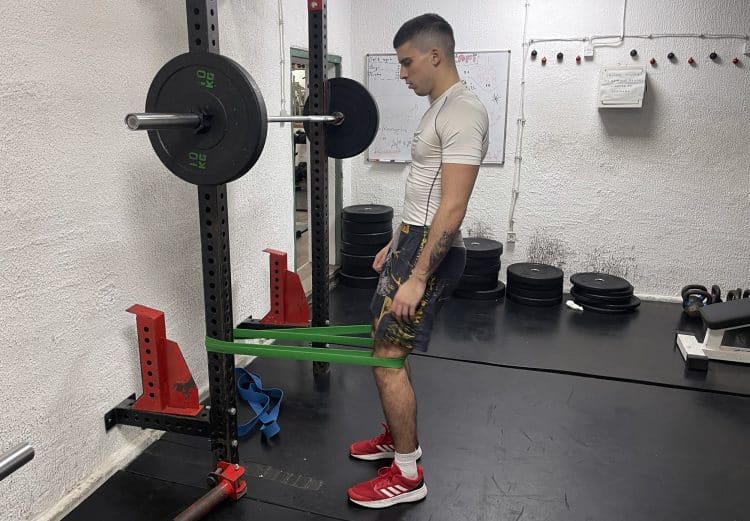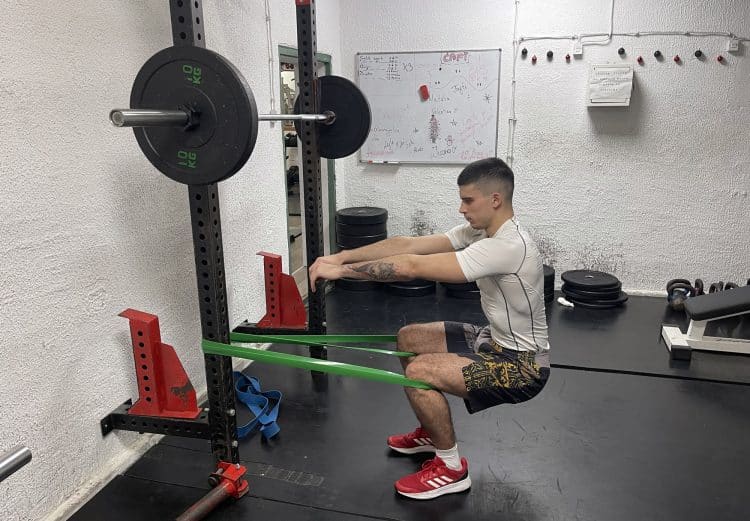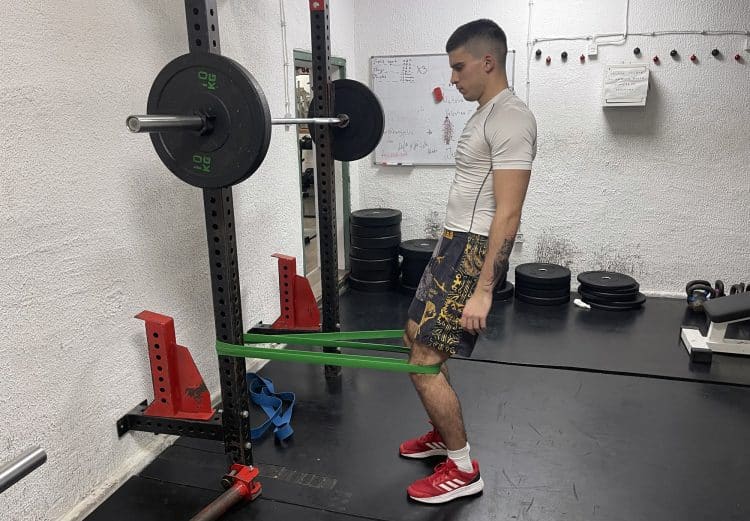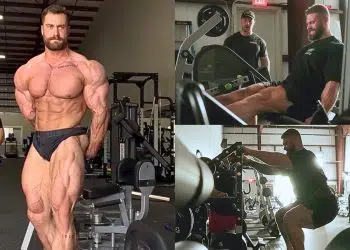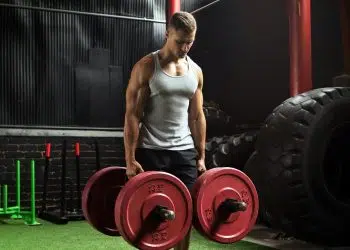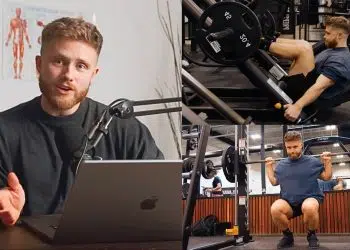I was first introduced to Spanish squats when I was still playing basketball. Back then, it was one of the hardest lower body exercises I have ever tried. Spanish squats are highly effective at targeting the majority of lower body muscles.
A study titled “Differences in the muscle activities of the quadriceps femoris and hamstrings while performing various squat exercises” found that Spanish squats lead to greater activation in the rectus femoris and vastus lateralis muscles than the general squats and wall sits. (1)
This is why many fitness enthusiasts and athletes who lack activation in these muscles use Spanish squats for leg workouts.
Below, I will cover the proper form and technique of Spanish squats, the best tips, the most common mistakes, and some alternatives for your future workouts.
How To Do Spanish Squats
Here is how to do Spanish squats:
Step One — Assume the Starting Position
Level Up Your Fitness: Join our 💪 strong community in Fitness Volt Newsletter. Get daily inspiration, expert-backed workouts, nutrition tips, the latest in strength sports, and the support you need to reach your goals. Subscribe for free!
Take a resistance band that can handle your body weight during a squat. Wrap it around a squat rack or some sturdy object at knee level.
Thread your legs through the resistance band’s loops, ensuring it sits at knee level. Take one or two steps back so the resistance band is taut. Assume a shoulder-width stance with your feet and point your toes slightly outward.
Optional: Use a small kettlebell or dumbbell to counter the weight if your hands aren’t enough.
Pro Tip: Ensure the resistance band is evenly positioned and securely anchored at knee level. Uneven tension can lead to imbalanced muscle engagement and potential strain.
Step Two — Enter the Bottom Squat Position
Simultaneously, bend your ankles, knees, and hips to enter the bottom squat position. Lower until your thighs are parallel to the ground. Extend your arms in front of you to counter the weight and achieve better stability. Make sure your back is straight throughout the whole movement.
Also, the angle between your torso and upper legs should be close to 90 degrees at the bottom of the range of motion. Hold the bottom position for one second before proceeding with the following step.
Pro Tip: Visualize an imaginary chair behind you and aim to sit back into it. Focus on moving your hips back first rather than starting the movement with your knees.
Step Three — Extend Ankles, Knees, and Hips
Extend your ankles, knees, and hips to return to the starting position. Make sure your back is straight during this phase. As you return to the starting position, slowly bring your hands back from extended to bent position. Proceed with the next repetition.
Pro Tip: Engage your core and glutes. This aids in maintaining a straight back but also ensures a controlled, stable ascent.
Muscles Worked During Spanish Squat
Here are the primary target muscles of this exercise:
- Quadriceps
- Glutes
Also, here are the secondary muscles worked:
- Hamstrings
- Calves
- Core musculature
Best Tips for Performing Spanish Squats
Some of the best tips I recommend to my clients include:
Find a Stable Anchor Point
The first step is always to ensure safety. You do that by finding a stable anchor point for the resistance band. The object must be sturdy, something like a squat rack, cable machine, or functional trainer.
Avoid objects such as free weights and weight benches. These tend to move and can be unstable, increasing injury risk.
Position Your Feet Correctly
At the start of the exercise, ensure your feet are shoulder-width apart. Also, ensure your toes are positioned slightly outward. Your knees must be in line with your toes. The point of stance is to provide enough stability during the exercise. Too narrow a stance will cause instability and put too much pressure on your knees.
On the contrary, too wide of a stance will also cause instability, more stress on your adductors, and a lesser range of motion.
Level Up Your Fitness: Join our 💪 strong community in Fitness Volt Newsletter. Get daily inspiration, expert-backed workouts, nutrition tips, the latest in strength sports, and the support you need to reach your goals. Subscribe for free!
Start with Fewer Repetitions
Spanish squats are a challenging exercise, especially if you are a beginner or doing them for the first time. Starting with fewer reps will ensure you drill the proper form. Then, you should add reps and sets to increase workout intensity.
When bodyweight Spanish squats become too easy, transition to the best possible weighted alternative — Swiss ball hack squats. I did this during the offseason while preparing for the basketball session a couple of years ago. Let’s just say I don’t miss this variation at all.
Listen to Your Body
If you feel extreme pain or discomfort, you must stop immediately. Listening to what your body is telling you is crucial during any workout. You shouldn’t work out under acute pain.
That said, you must understand the difference between discomfort and actually feeling back pain during squatting, for example.
Breathe Properly
Inhale during eccentrics and exhale during concentrics. Incorporating sharp and quick abdominal breathing, more precisely exhaling, is crucial during every exercise. It will help you perform the movement more efficiently without spending more energy than necessary. Always have energy optimization in mind.
Also, breathing, which is required for adenosine triphosphate synthesis (ATP), is crucial for your aerobic system. In addition to that, when you indulge in intense activities and exercises, your body creates lactates, and oxygen is vital for clearing blood lactate for the mid and post-workout. (2)
Most Common Spanish Squat Mistakes
The most common Spanish squat errors include:
Incorrect Band Positioning
Positioning your band too high or too low will cause instability. In my experience, the best spot to place the band is just below your knees. This positioning will ensure you maintain balance during concentrics and eccentrics.
Poor Posture
Always ensure your back is straight during Spanish squats. You do that by assuming the proper positioning at the beginning of the exercise. In addition to that, you must activate your core and hips to fixate your spine. If you fail to place your back, shoulder blades, and shoulders in the proper position, you will likely experience pain or even injure yourself.
Knees Caving In
Don’t let your knees cave in. Doing so places excessive stress on your collateral ligaments, such as the ACL. If you are unfamiliar with ACL injuries, let’s just say it is one of the worst ones. You must undergo surgery, rehab takes forever, you can’t walk normally, and the worst thing is no gym for the next six to 12 months.
Although Spanish squats are primarily bodyweight exercises, improper knee positioning can lead to excessive pressure. Sometimes, this ends up in nasty injuries.
Not Engaging Core Muscles
Failing to engage your core muscles will result in trunk instability. Trunk instability is almost the same as whole-body instability. Engage your core and hip muscles to maintain balance and good posture throughout the exercise.
Ignoring Pain or Discomfort
Don’t ignore extreme pain or discomfort. More often than not, these are signs that you should stop the exercise immediately. However, learn to differentiate between discomfort and real pain. The first is a good thing, and you should continue to exercise, while the second is a sign to stop immediately.
Best Spanish Squat Alternatives
The two best Spanish squat alternatives are wall sits and Swiss ball hack squats.
Wall Sits
Wall sits are an excellent isometric exercise that develops lower body strength and endurance.
Steps:
- Place your back on the wall and enter the half-squat position.
- Your thighs should be parallel to the ground.
- Assume a shoulder-width stance with your feet.
- Keep your back against the wall throughout the entire exercise.
- Hold the position for 25 to 45 seconds.
- When you finish, get up, rest between 45 and 90 seconds, and repeat.
Pro Tip: Focus on pressing your entire back against the wall, including the lower back. This ensures proper spinal alignment, which maximizes muscle engagement and reduces the risk of lower back strain.
Barbell Swiss Ball Hack Squat
If I were woken up in the middle of the night and asked about the exercise I despise the most, this would undoubtedly be it. Barbell Swiss ball hack squats are a great progressive exercise to Spanish squats, but they are as tough as they come.
Steps:
- Load the barbell on the floor and place it in front of a wall.
- Press a Swiss ball against the wall with your back.
- The ball must be just above your hip level.
- Assume a shoulder-width stance with your feet and turn your toes slightly outward.
- Bend down and grab the barbell with a pronated or mixed grip.
- Push through your heels to lift the barbell and stand upright.
- Slowly reverse the movement to return the barbell to the starting position.
Pro Tip: Concentrate on engaging your core muscles throughout the entire movement to maintain stability and balance. Also, focus on a slow and controlled descent to maintain balance.
Wrapping Up
Spanish squats are one of my favorite exercises for effectively targeting your glutes and quads. My advice is always to ensure you find a stable anchor point, position your feet correctly, start with fewer reps, listen to your body, and breathe properly.
In addition to that, you should avoid common mistakes such as incorrect band positioning, poor posture, knees caving in, not engaging your core, and ignoring pain or discomfort. In the comments below, let me know your thoughts on Spanish squats and how you plan to incorporate them into your workout routine.
References
- Lee JH, Kim S, Heo J, Park DH, Chang E. Differences in the muscle activities of the quadriceps femoris and hamstrings while performing various squat exercises. BMC Sports Sci Med Rehabil. 2022;14(1):12. Published 2022 Jan 21. doi:10.1186/s13102-022-00404-6
- Menzies P, Menzies C, McIntyre L, Paterson P, Wilson J, Kemi OJ. Blood lactate clearance during active recovery after an intense running bout depends on the intensity of the active recovery. J Sports Sci. 2010;28(9):975-982. doi:10.1080/02640414.2010.481721
Relevant Articles:
Interested in measuring your progress? Check out our strength standards for Hack Squat, Half Squat, Squat, and more.

